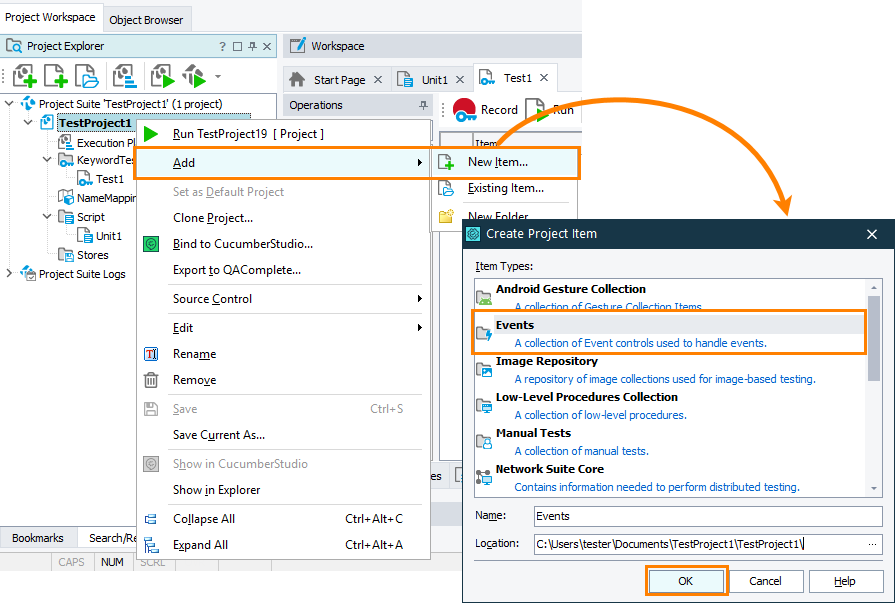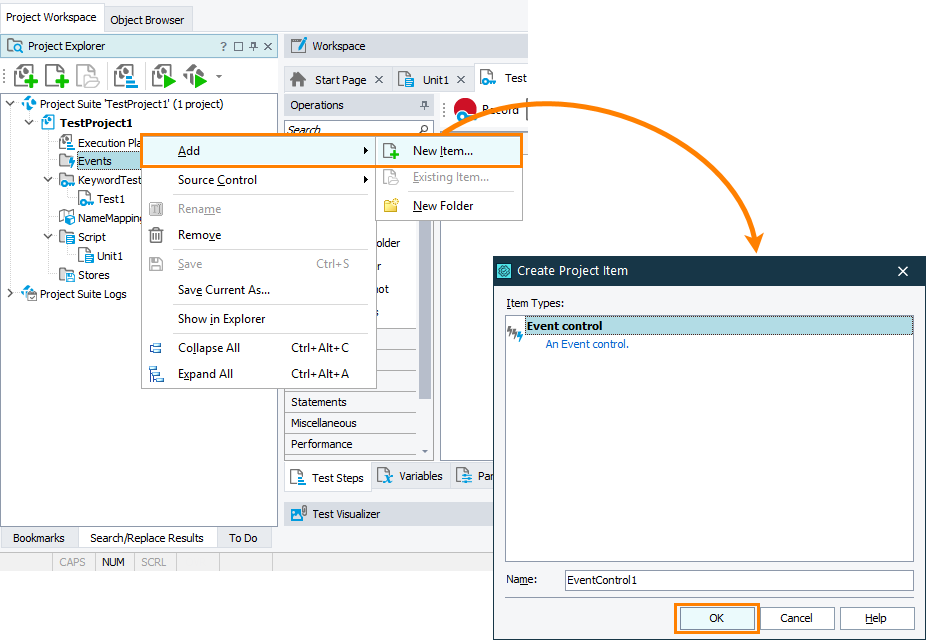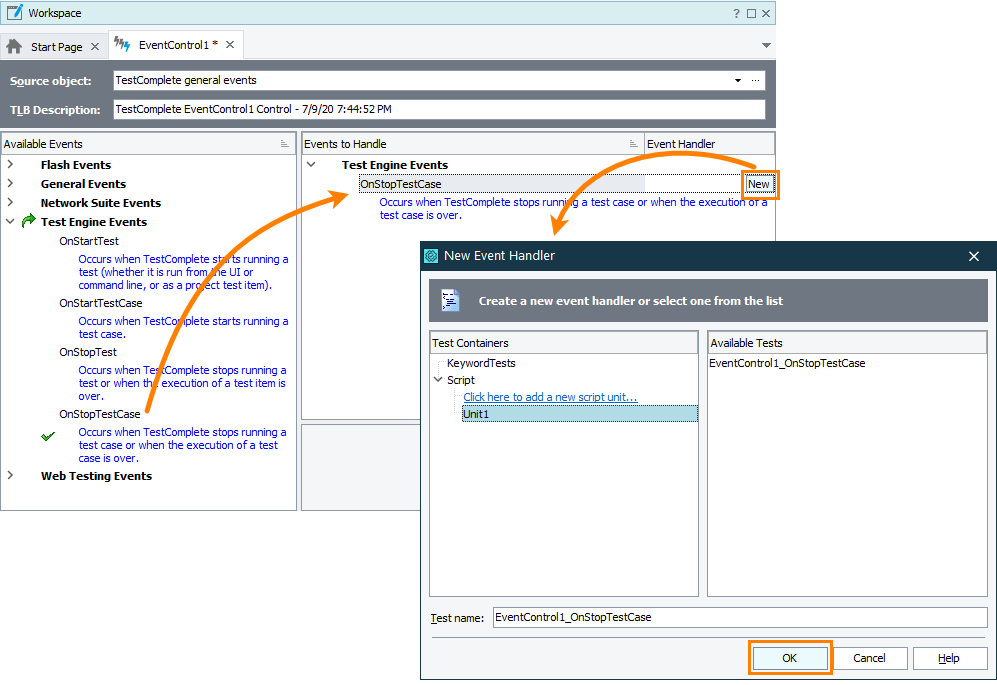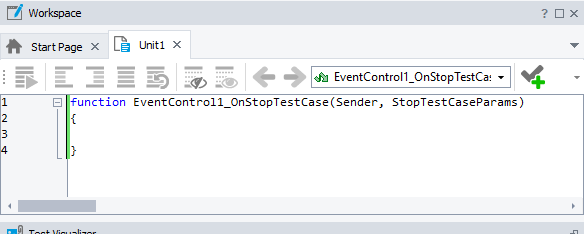Test Management Systems (TMS) are software tools that help you manage and monitor your testing process. You can create and store test cases there, organize them into test runs, and analyze the results of their executions.
Supported TMS
TestComplete can integrate with almost any test management system. TestComplete has built-in integrations with the following test management systems:
-
Zephyr Squad – You can automate your test cases by assigning TestComplete tests to them and send the test results to Jira.
-
Azure Test Plans – You can run TestComplete tests as part of your pipeline or use TestComplete tests to automate manual test cases you manage with test plans.
-
QAComplete – You can export your TestComplete tests to the QAComplete Test Library and submit defects to QAComplete directly from TestComplete.
Integration with Zephyr Enterprise is implemented via Automated Jobs you configure in Zephyr. For complete information, see the Zephyr Enterprise documentation.
Other TMS
To integrate with other test management systems, use the OnStopTestCase event handler. You can configure the event handler to send information about test cases that TestComplete runs to your test management system.
Requirements
Your TMS system must have a way to submit results to a specific test case, for example, using an API call.
1. Mark desired test items as test cases
The OnStopTestCase event handler is triggered when a test case run is over. To mark test items as test cases, use one of the following approaches:
-
Select the Test Case check boxes in the Execution Plan editor.
-
Use the
aqTestCase.BeginandaqTestCase.Endmethods in your script tests.
| Note: | BDD scenarios and features, and tests specified via tags are always treated as test cases. You do not need to mark them manually. |
For more information about test cases, see Tests, Test Items, and Test Cases.
2. Add the OnStopTestCase event handler
-
Right-click your project node in the Project Explorer panel, select Add > New Item in the subsequent dialogs. In the Create Project Item dialog, select Events and then click OK:
TestComplete will add the Events project item to your project.
-
Right-click the added Events item and add the Event control in a similar way:
After you click OK, TestComplete will open the Event Control Editor.
-
Expand the Test Engine Events section of the Available Events list and drag the OnStopTestCase item to the Events to Handle list on the right. Select the added item and click New next to it. TestComplete will display the New Event Handler dialog:
-
In the dialog, specify either the event-handling routine or the keyword test that contains the event-handling instructions. In our example, we will add the event handler to the script unit. To learn how you can use event handlers in keyword tests, see Creating Event Handlers for TestComplete Events.
After you click OK, TestComplete will add the
OnStopTestCaseevent handler to your script test:
3. Write the event handler
In the event handler added on the previous step, enter the code that will send the information on the test case to your test management system. To get the information, use the StopTestCaseParams parameter of the OnStopTestCase event handler. It provides the information about the executed test case (for example, the name of the test case, its status). For more information, see Properties of the StopTestCaseParams object.
Here is an example of how to send test case results to TestRail:
JavaScript, JScript
// Before using this example, enable TestRails API
// in TestRails > Administration > Site Settings > API
function EventControl1_OnStopTestCase(Sender, StopTestCaseParams)
{
var testId = 1; // TestRail ID of the test to add the result to
var address = "https://mysite.testrail.io/index.php?/api/v2/add_result/" + testId;
var username = "[email protected]";
var password = "p@55w0rd";
// Convert the user credentials to base64 for preemptive authentication
var credentials = aqConvert.VarToStr(dotNET.System.Convert.ToBase64String
(dotNET.System_Text.Encoding.UTF8.GetBytes_2(username + ":" + password)));
var request = aqHttp.CreatePostRequest(address);
request.SetHeader("Authorization", "Basic " + credentials);
request.SetHeader("Content-Type", "application/json");
var statusId;
var comment = "";
switch (StopTestCaseParams.Status)
{
case 0: // lsOk
statusId = 1; // Passed
break;
case 1: // lsWarning
statusId = 1; // Passed with a warning
comment = StopTestCaseParams.FirstWarningMessage;
break;
case 2: // lsError
statusId = 5; // Failed
comment = StopTestCaseParams.FirstErrorMessage;
break;
}
var requestBody =
{
"status_id": statusId,
"comment": comment
};
var response = request.Send(JSON.stringify(requestBody));
if (response.StatusCode != aqHttpStatusCode.OK)
{
Log.Warning("Failed to send results to TestRail. See the Details in the previous message.");
}
}
Python
# Before using this example, enable TestRails API
# in TestRails > Administration > Site Settings > API
import json
import base64
def EventControl1_OnStopTestCase(Sender, StopTestCaseParams):
testId = 1 # TestRail ID of the test to add the result to
address = "https://mysite.testrail.io/index.php?/api/v2/add_result/" + str(testId)
username = "[email protected]"
password = "p@55w0rd"
# Convert the user credentials to base64 for preemptive authentication
credentials = base64.b64encode((username + ":" + password).encode("ascii")).decode("ascii")
request = aqHttp.CreatePostRequest(address)
request.SetHeader("Authorization", "Basic " + credentials)
request.SetHeader("Content-Type", "application/json")
comment = ""
if StopTestCaseParams.Status == 0: # lsOk
statusId = 1 # Passed
elif StopTestCaseParams.Status == 1: # lsWarning
statusId = 1 # Passed with a warning
comment = StopTestCaseParams.FirstWarningMessage
elif StopTestCaseParams.Status == 2: # lsError
statusId = 5 # Failed
comment = StopTestCaseParams.FirstErrorMessage
requestBody = {
"status_id": statusId,
"comment": comment
}
response = request.Send(json.dumps(requestBody))
if response.StatusCode != aqHttpStatusCode.OK:
Log.Warning("Failed to send results to TestRail. See the Details in the previous message.")VBScript
' Before using this example, enable TestRails API
' in TestRails > Administration > Site Settings > API
Sub EventControl1_OnStopTestCase(Sender, StopTestCaseParams)
Dim testId, address, username, password, credentials, request, statusId, comment, requestBody, response
testId = 1 ' TestRail ID of the test to add the result to
address = "https://mysite.testrail.io/index.php?/api/v2/add_result/" & testId
username = "[email protected]"
password = "p@55w0rd"
comment = ""
' Convert the user credentials to base64 for preemptive authentication
credentials = aqConvert.VarToStr(dotNET.System.Convert.ToBase64String _
(dotNET.System_Text.Encoding.UTF8.GetBytes_2(username + ":" + password)))
Set request = aqHttp.CreatePostRequest(address)
Call request.SetHeader("Authorization", "Basic " + credentials)
Call request.SetHeader("Content-Type", "application/json")
Select Case StopTestCaseParams.Status
Case 0 ' lsOk
statusId = 1 ' Passed
Case 1 ' lsWarning
statusId = 1 ' Passed with a warning
comment = StopTestCaseParams.FirstWarningMessage
Case 2 ' lsError
statusId = 5 ' Failed
comment = StopTestCaseParams.FirstErrorMessage
End Select
requestBody = "{""status_id"": """ & statusId & """, ""comment"": """ & comment & """}"
Set response = request.Send(requestBody)
If Not response.StatusCode = aqHttpStatusCode.OK Then
Log.Warning("Failed to send results to TestRail. See the Details in the previous message.")
End If
End Sub
DelphiScript
// Before using this example, enable TestRails API
// in TestRails > Administration > Site Settings > API
procedure EventControl1_OnStopTestCase(Sender, StopTestCaseParams);
var testId, address, username, password, credentials, request, statusId, comment, requestBody, response;
begin
testId := 1; // TestRail ID of the test to add the result to
address := 'https://mysite.testrail.io/index.php?/api/v2/add_result/' + VarToStr(testId);
username := '[email protected]';
password := 'p@55w0rd';
// Convert the user credentials to base64 for preemptive authentication
credentials := aqConvert.VarToStr(dotNET.System.Convert.ToBase64String
(dotNET.System_Text.Encoding.UTF8.GetBytes_2(username + ':' + password)));
request := aqHttp.CreatePostRequest(address);
request.SetHeader('Authorization', 'Basic ' + credentials);
request.SetHeader('Content-Type', 'application/json');
comment := '';
case StopTestCaseParams.Status of
0: // lsOk
statusId := '1'; // Passed
1: // lsWarning
begin
statusId := '1'; // Passed with a warning
comment := StopTestCaseParams.FirstWarningMessage;
end;
2: // lsError
begin
statusId := '5'; // Failed
comment := StopTestCaseParams.FirstErrorMessage;
end;
end;
requestBody := '{"status_id": "' + statusId + '","comment": "' + comment + '"}';
response := request.Send(requestBody);
if response.StatusCode <> aqHttpStatusCode.OK then
begin
Log.Warning('Failed to send results to TestRail. See the Details in the previous message.');
end;
end;
C++Script, C#Script
// Before using this example, enable TestRails API
// in TestRails > Administration > Site Settings > API
function EventControl1_OnStopTestCase(Sender, StopTestCaseParams)
{
var testId = 1; // TestRail ID of the test to add the result to
var address = "https://mysite.testrail.io/index.php?/api/v2/add_result/" + testId;
var username = "[email protected]";
var password = "p@55w0rd";
// Convert the user credentials to base64 for preemptive authentication
var credentials = aqConvert["VarToStr"](dotNET["System"]["Convert"]["ToBase64String"]
(dotNET["System_Text"]["Encoding"]["UTF8"]["GetBytes_2"](username + ":" + password)));
var request = aqHttp["CreatePostRequest"](address);
request["SetHeader"]("Authorization", "Basic " + credentials);
request["SetHeader"]("Content-Type", "application/json");
var statusId;
var comment = "";
switch (StopTestCaseParams["Status"])
{
case 0: // lsOk
statusId = 1; // Passed
break;
case 1: // lsWarning
statusId = 1; // Passed with a warning
comment = StopTestCaseParams["FirstWarningMessage"];
break;
case 2: // lsError
statusId = 5; // Failed
comment = StopTestCaseParams["FirstErrorMessage"];
break;
}
var requestBody =
{
"status_id": statusId,
"comment": comment
};
var response = request["Send"](JSON["stringify"](requestBody));
if (response["StatusCode"] != aqHttpStatusCode["OK"])
{
Log["Warning"]("Failed to send results to TestRail. See the Details in the previous message.");
}
}
4. Run test cases and view results
Run your tests. For complete information about running tests in TestComplete, see Running Tests.
When the test case execution is over, its results are sent to your system. To view the results, switch to your test management system.
See Also
Integration Into QA Process
OnStopTestCase Event
Integration With Zephyr Squad
Integration With QAComplete




